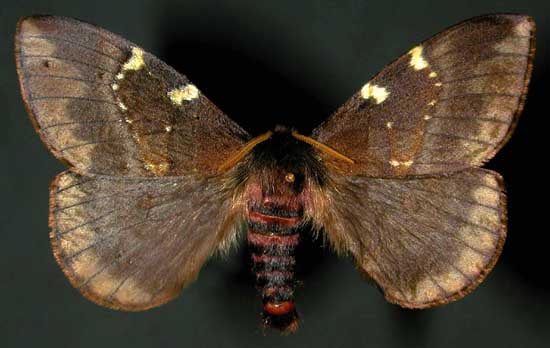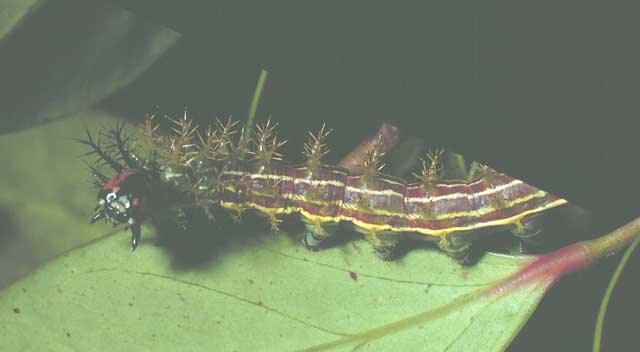Paradirphia winifredae
Paradirphia winifredae
pah-ruh-DIRF-ee-uhMwih-NIH-fred-ay
Lemaire & Wolfe, 1990

Paradirphia winifredae male courtesy of Dan Janzen.
TAXONOMY:
Superfamily: Bombycoidea, Latreille, 1802
Family: Saturniidae, Boisduval, [1837] 1834
Subfamily: Hemileucinae, Grote & Robinson, 1866
Tribe: Hemileucinae, Grote & Robinson, 1866
Genus: Paradirphia Michener, 1949
|
MIDI MUSIC
"Someone to Watch
Over Me"
copyright C. Odenkirk
MIDI CITY
ON.OFF
<bgsound src="watch.mid" LOOP=FOREVER>
|
DISTRIBUTION:
Paradirphia winifredae (wingspan: males: 72mm; females: ) flies in
Costa Rica: Alajuela, Cartago, Puntarenas,
San Jose (CL), Guanacaste, Heredia (IB); and
Panama: Chiriqui.

Paradirphia winifredae male, 72mm, Cartago, Costa Rica,
on my home computer only.

Paradirphia winifredae/herediana? male, Mount Totumas Cloud Forest, Chiriqui, Panama,
1600m +, courtesy of Jeffrey Dietrich.
In Lemaire's Hemileucinae 2002, the only Paradirphia species recorded for Panama is Paradirphia winifredae, which is also recorded from
Chiriqui. Lemaire does not list P. semirosea from Panama, but the above specimen seems a better match for semirosea than for winifredae, especially
due to the lilac/purplish shading in the lower half of the median area. P. winifredae is generally darker brown in colour and lacks purplish shading
in median area, but maybe the lighting is playing tricks on me. The orange inward tracing of the pm line is a character of winifredae.
The Entomo-Satsphingia image shows a very strongly contrasting lighter outward tracing of the forewing pm line, consistent with the Panama and Costa Rica images on this page.
FLIGHT TIMES AND PREFERRED FOOD PLANTS:
This species probably broods continuously.
Dan Janzen reports larvae feeding on Gonocalyx pterocarpus,
Miconia lonchophylla, Vaccinium poasanum, Weinmannia burseraefolia and Weinmannia wercklei in Costa Rica.
ECLOSION, SCENTING AND MATING:
Females extend a scent gland from the tip of the abdomen, and the night-flying males pick up and track the airbourne
pheromone plume with their well-developed antennae.

Paradirphia winifredae female courtesy of
Dan Janzen.
EGGS, LARVAE, COCOONS AND PUPAE:
Eggs are deposited in
clusters on hostplant foliage.
Paradirphia winifredae larvae are highly gregarious and have the
urticating spines typical of larvae from the Subfamily Hemileucinae.

Paradirphia winifredae, Costa Rica, courtesy of
Dan Janzen

Paradirphia winifredae, Costa Rica, courtesy of
Dan Janzen
Larval Food Plants
It is hoped that this alphabetical listing followed by the
common name of the foodplant will prove useful. The list is not
exhaustive. Experimenting with closely related foodplants is
worthwhile.
Gonocalyx pterocarpus
Miconia lonchophylla
Vaccinium poasanum
Weinmannia burseraefolia ........
Weinmannia wercklei
|
Gonocalyx pterocarpus
Miconia lonchophylla
Vaccinium poasanum
Weinmannia burseraefolia
Weinmannia wercklei
|
Use your browser "Back" button to return to the previous page.
Return to Paradirphia Index
Goto Mexico and Central American Saturniidae Index
Goto Main Index
The pronunciation of scientific names is
troublesome for many. The "suggestion" at the top of the page is
merely a suggestion. It is based on commonly
accepted English pronunciation of Greek names and/or some
fairly well accepted "rules" for latinized scientific names.
The suggested pronunciations, on this page and on other pages,
are primarily put forward to assist those who hear with internal
ears as they read.
There are many collectors from different countries whose
intonations and accents would be different.
Some of the early describers/namers chose genus
and species names indicating some character of the insect, but more
often, they simply chose names from Greek or Roman mythology or
history.Those species names which end in "ensis" indicate a
specimen locale, and those which end in "i", pronounced "eye", honour
a contempory friend/collector/etc.
I do not know the source of the genus
name "Paradirphia" chosen by Michener in 1849, but it
probably has to do with the similarity of these moths to those
in the genus Dirphia.
The species name "winifredae" is honourific for a woman named Winifred.





